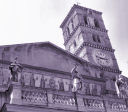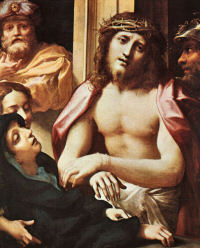Lent: February 29th
Monday of the Third Week of Lent
Other Commemorations: St. Oswald, Bishop (RM)
» Enjoy our Liturgical Seasons series of e-books!
"Do not be amazed at this, because the hour is coming in which all who are in the tombs will hear his voice and will come out, those who have done good deeds to the resurrection of life, but those who have done wicked deeds to the resurrection of condemnation (Jn. 5:28-29)."
Before the reform of the Roman Calendar this was the feast of St. John de Brefeuf. His feast has been transferred to October 19.
Meditation - The Tree of Knowledge and the Cross
The sin that was wrought through the tree was undone by the obedience of the tree, obedience to God whereby the Son of man was nailed to the tree, destroying the knowledge of evil, and bringing in and conferring the knowledge of good; and evil is disobedience to God, as obedience to God is good. And therefore the Word says through Isaiah the prophet, foretelling what was to come to pass in the future—for it was because they told the future that they were "prophets"—the Word says through him as follows: I refuse not, and do not gainsay, my back have I delivered to blows and my cheeks to buffets, and I have not turned away my face from the contumely of them that spat. [Is. 50, 6] So by obedience, whereby He obeyed unto death, hanging on the tree, He undid the old disobedience wrought in the tree. And because He is Himself the Word of God Almighty, who in His invisible form pervades us universally in the whole world, and encompasses both its length and breadth and height and depth—for by God's Word everything is disposed and administered—the Son of God was also crucified in these, imprinted in the form of a cross on the universe; for He had necessarily, in becoming visible, to bring to light the universality of His cross, in order to show openly through His visible form that activity of His: that it is He who makes bright the height, that is, what is in heaven, and holds the deep, which is in the bowels of the earth, and stretches forth and extends the length from East to West, navigating also the Northern parts and the breadth of the South, and calling in all the dispersed from all sides to the knowledge of the Father. — St. Irenaeus
Things to Do:
- Today's reading from the book of Isaiah declares that the fasting desired by the Lord is not so much denying oneself food (although this is important) but rather, consists in "Sharing your bread with the hungry, sheltering the oppressed and the homeless; / Clothing the naked when you see them, and not turning your back on your own." Many families take these words to heart by having an inexpensive, penitential dinner on Fridays in Lent (such as beans and rice) and then giving the extra money to the poor.
- Many families give each child one pretzel during Friday dinners in Lent. Remind your children of the spiritual significance of the pretzel.
- Pray the Stations of the Cross today with your family. An excellent version with beautiful meditations composed by our Holy Father is his Stations of the Cross at the Colosseum. Some other recommended versions are: Eucharistic Stations of the Cross, and the more traditional Stations of the Cross written by Saint Alphonsus Liguori can be found in most Catholic bookstores. Here are some guidelines for praying the Stations of the Cross in your home.
- Any of the linked activities (Fun Pretzel Project, Lenten Scrapbook, Candelabrum for Stations of the Cross) are a perfect way for your children to spend their Friday afternoons throughout this season of Lent.

The Station is in the church of St. Mark, which was built in the fourth century in honor of the evangelist, by the holy Pope Mark, whose relics are kept there.
St. Oswald of Worcester
St. Oswald was born of a Danish family that settled in England. He was educated by his uncle St. Odo, bishop of Canterbury, was appointed dean of Winchester, and soon after sent by Odo to the abbey of Fleury in France to learn monastic discipline.
In 962, Oswald succeeded St. Dunstan as bishop of Worcester, and he was closely associated with Dunstan and St. Ethelwold in the restoration of monasticism in England. His first foundation was at Westbury-on-Trym near Bristol, but his greatest establishment was at Ramsey in Huntingdonshire (972), from which were founded Pershore, Evesham, and other houses.
St. Oswald shone as a bright star as bishop. He was energetic in improving the standard of the parochial clergy, fostering education, and enforcing clerical celibacy, and in 972 he was promoted to archbishop of York, where as a young man he had worked under his uncle Archbishop Oskitell (Oskytel). But he was obliged to retain the see of Worcester as well, presiding over both dioceses; it is with Worcester that he was always concerned.
St. Oswald was almost always occupied in visiting his diocese, preaching without intermission, and reforming abuses. He encouraged learning and learned men. When not engaged in pastoral duties, Oswald could be found joining the monks of St. Mary's monastery in their exercises.
To nourish his own humility and charity, Oswald always invited 12 of the poor to dine with him each day during Lent (some say every day). These he served himself, and also washed and kissed their feet. He died at St. Mary's just after fulfilling this Lenten observance and after receiving the viaticum, while repeatedly praying the Glory Be.
His body was translated by his successor Adulph ten years later and enshrined. Still later his relics were transferred to York.
—Adapted from Celtic Saints
Symbols and Representation: church; demon; dove; ship; stone
Highlights and Things to Do:
- Read more about St. Oswald:
- St. Oswald's remains are located in the Worcester Cathedral.
 Thursday of the Second Week of Lent
Thursday of the Second Week of Lent
Station with Santa Maria in Trastevere (St. Mary in Trastevere ):
The Station for today is in the celebrated basilica, St. Maria in Trastevere. The basilica was consecrated in the third century, under the pontificate of St. Callixtus, and was the first church built in Rome in honor of our Blessed Lady, particularly for her Assumption. The original church was demolished and the current church was constructed between 1139 to 1181, with additions such as mosaics and chapels added through the centuries.
For more on Santa Maria in Trastevere, see:
For further information on the Station Churches, see The Stational Church.






